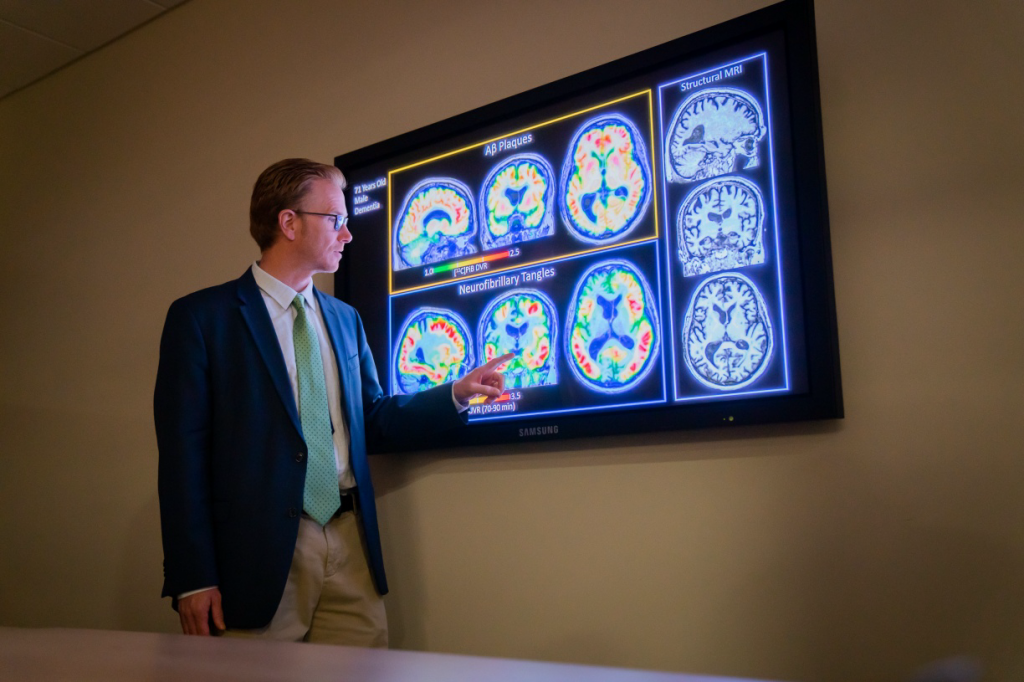Funding Cuts Would Cost UW-Madison $65 Million Annually, Hamper Alzheimer’s Research
UW research center was substantial contributor to new Alzheimer's blood test.

UW-Madison professor Sterling Johnson examines images from PET scans that may show markers in the brain that are associated with Alzheimer’s disease and other dementias. Photo courtesy UW-Madison
Researchers at the University of Wisconsin-Madison were critical to the development of a new blood test recently approved to help diagnose Alzheimer’s disease.
But researchers said their future work could be jeopardized by proposed cuts to federal grants for health research.
A federal attempt to cap “indirect cost” awards included in National Institutes of Health grants at 15% could cost UW-Madison about $65 million annually if it survives the courts.
If those funds are cut and can’t be made up elsewhere, Alzheimer’s research in Wisconsin could suffer, said Sterling Johnson, the associate director of UW-Madison’s Wisconsin Alzheimer’s Disease Research Center.
“There would be a significant impact on not just Alzheimer’s research, but all the research we do here at UW,” said Johnson.
In 2020, an estimated 120,000 Wisconsinites were living with Alzheimer’s disease and scientists predict the number of cases across the nation annually to rise. UW-Madison researchers have contributed to yearslong studies on the disease.
The NIH’s action to cap indirect costs is contested in a multi-state lawsuit that includes Wisconsin. The suit says the rate change “will devastate critical public health research at universities and research institutions in the United States.”
“NIH is complying with President Trump’s Executive Order, Radical Transparency About Wasteful Spending, so taxpayer dollars are used to promote the interests of the American people,” the NIH wrote in a statement to WPR. “Most major funders, such as the Gates Foundation, cap overhead at 15%. This raises a fair question: why should U.S. taxpayers pay significantly higher rates than other funders? In other words, if a research organization will accept 15%, why is it necessary the NIH pay so much more?”
UW-Madison leadership recently announced a plan to cut budgets across departments up to 7%, citing potential changes to federal indirect funds as one reason.
Johnson said the researchers at his Alzheimer’s center don’t anticipate a direct loss in federal dollars, which make up over 90% of their funding. But a cut to indirect costs could have impacts across the university.
“If the indirect cost rate is decreased, then it will significantly change the way that research is supported at big universities like the University of Wisconsin,” Johnson said. “I don’t know what that would look like or how it would affect us.”
He said indirect costs pay for building maintenance, electricity, administrative support and even patient safety policies that Alzheimer’s researchers rely on to do their studies.
“Ultimately, it has an impact on our ability to keep patients safe and to comply with federal regulations regarding safety and appropriate human subjects research,” Johnson said.
“With these kinds of decisions going through the court system and negotiations happening in Congress, I’m hoping that there’ll be a solution that works for everybody,” he added.
Collecting Alzheimer’s disease data since 2001
Doctor and professor Nathaniel Chin is the medical director of UW-Madison’s Wisconsin Registry for Alzheimer’s Prevention study. For over two decades, researchers on the project have collected data from over 1,700 participants to understand disease risk.
Recently, that data helped yield the first FDA-approved blood test for Alzheimer’s disease diagnosis.
“Wisconsin contributed 40% of the data that led to that approval,” Chin said.
He said the blood test could help lower barriers for patients to get diagnosed, such as cost and access.
“A rural clinic in Wisconsin could run this blood test,” Chin said. “It really opens the door for accurate diagnoses everywhere.”
He said the work wouldn’t have been possible without NIH funding. And the researchers’ ultimate goals are to prevent, stop progression and ideally cure Alzheimer’s.
“All of this is going to take more federal funding to accomplish,” Chin said.
Editor’s note: Wisconsin Public Radio is a service of the University of Wisconsin-Madison and the Wisconsin Educational Communications Board.
Proposed federal cuts could jeopardize Wisconsin Alzheimer’s research was originally published by Wisconsin Public Radio.
If you think stories like this are important, become a member of Urban Milwaukee and help support real, independent journalism. Plus you get some cool added benefits.




















